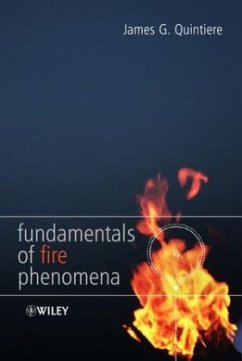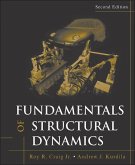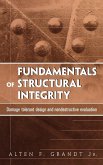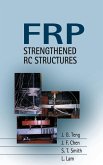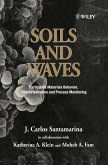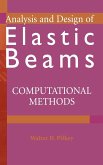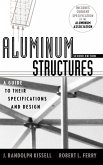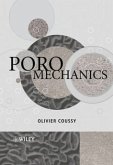James Quintiere
Fundamentals of Fire Phenomena
James Quintiere
Fundamentals of Fire Phenomena
- Gebundenes Buch
- Merkliste
- Auf die Merkliste
- Bewerten Bewerten
- Teilen
- Produkt teilen
- Produkterinnerung
- Produkterinnerung
Understanding fire dynamics and combustion is essential in fire safety engineering and in fire science curricula. Engineers and students involved in fire protection, safety and investigation need to know and predict how fire behaves to be able to implement adequate safety measures and hazard analyses. Fire phenomena encompass everything about the scientific principles behind fire behavior. Combining the principles of chemistry, physics, heat and mass transfer, and fluid dynamics necessary to understand the fundamentals of fire phenomena, this book integrates the subject into a clear…mehr
Andere Kunden interessierten sich auch für
![Fundamentals of Structural Dynamics Fundamentals of Structural Dynamics]() Roy R. CraigFundamentals of Structural Dynamics169,99 €
Roy R. CraigFundamentals of Structural Dynamics169,99 €![Fundamentals of Structural Integrity Fundamentals of Structural Integrity]() Alten F. GrandtFundamentals of Structural Integrity171,99 €
Alten F. GrandtFundamentals of Structural Integrity171,99 €![Frp Frp]() J G TengFrp161,99 €
J G TengFrp161,99 €![Soils and Waves Soils and Waves]() J. Carlos SantamarinaSoils and Waves363,99 €
J. Carlos SantamarinaSoils and Waves363,99 €![Analysis and Design of Elastic Beams Analysis and Design of Elastic Beams]() Walter D. PilkeyAnalysis and Design of Elastic Beams146,99 €
Walter D. PilkeyAnalysis and Design of Elastic Beams146,99 €![Aluminum Structures Aluminum Structures]() J. Randolph KissellAluminum Structures195,99 €
J. Randolph KissellAluminum Structures195,99 €![Poromechanics Poromechanics]() Olivier CoussyPoromechanics179,99 €
Olivier CoussyPoromechanics179,99 €-
-
-
Understanding fire dynamics and combustion is essential in fire safety engineering and in fire science curricula. Engineers and students involved in fire protection, safety and investigation need to know and predict how fire behaves to be able to implement adequate safety measures and hazard analyses. Fire phenomena encompass everything about the scientific principles behind fire behavior. Combining the principles of chemistry, physics, heat and mass transfer, and fluid dynamics necessary to understand the fundamentals of fire phenomena, this book integrates the subject into a clear discipline:
_ Covers thermochemistry including mixtures and chemical reactions;
_ Introduces combustion to the fire protection student;
_ Discusses premixed flames and spontaneous ignition;
_ Presents conservation laws for control volumes, including the effects of fire;
_ Describes the theoretical bases for empirical aspects of the subject of fire;
_ Analyses ignition of liquids and the importance of evaporation including heat and mass transfer;
_ Features the stages of fire in compartments, and the role of scale modeling in fire.
Fundamentals of Fire Phenomena is an invaluable reference tool for practising engineers in any aspect of safety or forensic analysis. Fire safety officers, safety practitioners and safety consultants will also find it an excellent resource. In addition, this is a must-have book for senior engineering students and postgraduates studying fire protection and fire aspects of combustion.
_ Covers thermochemistry including mixtures and chemical reactions;
_ Introduces combustion to the fire protection student;
_ Discusses premixed flames and spontaneous ignition;
_ Presents conservation laws for control volumes, including the effects of fire;
_ Describes the theoretical bases for empirical aspects of the subject of fire;
_ Analyses ignition of liquids and the importance of evaporation including heat and mass transfer;
_ Features the stages of fire in compartments, and the role of scale modeling in fire.
Fundamentals of Fire Phenomena is an invaluable reference tool for practising engineers in any aspect of safety or forensic analysis. Fire safety officers, safety practitioners and safety consultants will also find it an excellent resource. In addition, this is a must-have book for senior engineering students and postgraduates studying fire protection and fire aspects of combustion.
Produktdetails
- Produktdetails
- Verlag: Wiley & Sons
- 1. Auflage
- Seitenzahl: 464
- Erscheinungstermin: 17. März 2006
- Englisch
- Abmessung: 254mm x 174mm x 32mm
- Gewicht: 1040g
- ISBN-13: 9780470091135
- ISBN-10: 0470091134
- Artikelnr.: 13484316
- Herstellerkennzeichnung
- Libri GmbH
- Europaallee 1
- 36244 Bad Hersfeld
- gpsr@libri.de
- Verlag: Wiley & Sons
- 1. Auflage
- Seitenzahl: 464
- Erscheinungstermin: 17. März 2006
- Englisch
- Abmessung: 254mm x 174mm x 32mm
- Gewicht: 1040g
- ISBN-13: 9780470091135
- ISBN-10: 0470091134
- Artikelnr.: 13484316
- Herstellerkennzeichnung
- Libri GmbH
- Europaallee 1
- 36244 Bad Hersfeld
- gpsr@libri.de
James G. Quintiere, Department of Fire Protection Engineering, University of Maryland, College Park, MD 20742-3031, USA Educated as a mechanical engineer, Professor Quintiere received a B.S. degree from New Jersey Institute of Technology (1962), and a M.S. (1966) and Ph.D. (1970) from New York University. His career in fire safety began in 1971 when he joined the National Bureau of Standards, now known as the National Institute of Science and Technology. He left in 1989, as Chief of the Fire Science and Engineering Division, to join the faculty of the Department of Fire Protection Engineering. Dr. Quintiere's research in fire has covered a wide range of topics including compartment fire behavior, fire induced flows, fire growth on materials and scale model studies. He is currently Chairman of the International Association for Fire Safety Science (IAFSS). He received the Department of Commerce Bronze Medal (1976) and Silver Medal (1982) as well as the Howard W. Emmons Lecture Award from the IAFSS in 1986. He has written over 75 journal publications and reports.
Preface xiii
Nomenclature xvii
1 Introduction to Fire 1
1.1 Fire in History 1
1.2 Fire and Science 2
1.3 Fire Safety and Research in the Twentieth Century 8
1.4 Outlook for the Future 10
1.5 Introduction to This Book 11
1.5.1 Thermodynamics 13
1.5.2 Fluid mechanics 14
1.5.3 Heat and mass transfer 15
1.5.4 Supportive references 16
References 17
Problems 17
2 Thermochemistry 19
2.1 Introduction 19
2.2 Chemical Reactions 20
2.3 Gas Mixture 23
2.4 Conservation Laws for Systems 25
2.4.1 Constant pressure reaction 27
2.4.2 Heat of combustion 28
2.4.3 Adiabatic flame temperature 29
2.5 Heat of Formation 30
2.6 Application of Mass and Energy Conservation in Chemical Reactions 31
2.7 Combustion Products in Fire 35
References 41
Problems 41
3 Conservation Laws for Control Volumes 49
3.1 Introduction 49
3.2 The Reynolds Transport Theorem 50
3.3 Relationship between a Control Volume and System Volume 53
3.4 Conservation of Mass 54
3.5 Conservation of Mass for a Reacting Species 56
3.6 Conservation of Momentum 59
3.7 Conservation of Energy for a Control Volume 61
Problems 70
4 Premixed Flames 77
4.1 Introduction 77
4.2 Reaction Rate 78
4.3 Autoignition 80
4.4 Piloted Ignition 85
4.5 Flame Speed, Su 88
4.5.1 Measurement techniques 89
4.5.2 Approximate theory 90
4.5.3 Fuel lean results 93
4.5.4 Heat loss effects and extinction 93
4.6 Quenching Diameter 95
4.7 Flammability Limits 98
4.8 Empirical Relationships for the Lower Flammability Limit 102
4.9 A Quantitative Analysis of Ignition, Propagation and Extinction 105
4.9.1 Autoignition calculations 105
4.9.2 Piloted ignition calculations 107
4.9.3 Flame propagation and extinction calculations 107
4.9.4 Quenching diameter calculations 108
References 109
Problems 110
5 Spontaneous Ignition 117
5.1 Introduction 117
5.2 Theory of Spontaneous Ignition 119
5.3 Experimental Methods 124
5.4 Time for Spontaneous Ignition 127
References 130
Problems 131
6 Ignition of Liquids 135
6.1 Introduction 135
6.2 Flashpoint 135
6.3 Dynamics of Evaporation 137
6.4 Clausius-Clapeyron Equation 141
6.5 Evaporation Rates 146
References 154
Problems 154
7 Ignition of Solids 159
7.1 Introduction 159
7.2 Estimate of Ignition Time Components 161
7.2.1 Chemical time 161
7.2.2 Mixing time 162
7.2.3 Pyrolysis 163
7.3 Pure Conduction Model for Ignition 164
7.4 Heat Flux in Fire 166
7.4.1 Typical heat flux levels 166
7.4.2 Radiation properties of surfaces in fire 167
7.4.3 Convective heating in fire 167
7.4.4 Flame radiation 169
7.4.5 Heat flux measurements 170
7.4.6 Heat flux boundary conditions 170
7.5 Ignition in Thermally Thin Solids 171
7.5.1 Criterion for thermally thin 171
7.5.2 Thin theory 172
7.5.3 Measurements for thin materials 174
7.6 Ignition of a Thermally Thick Solid 176
7.6.1 Thick theory 176
7.6.2 Measurements for thick materials 180
7.6.3 Autoignition and surface ignition 182
7.7 Ignition Properties of Common Materials 184
References 188
Problems 188
8 Fire Spread on Surfaces and Through Solid Media 191
8.1 Introduction 191
8.2 Surface Flame Spread - The Thermally Thin Case 194
8.3 Transient Effects 198
8.4 Surface Flame Spread for a Thermally Thick Solid 200
8.5 Experimental Considerations for Solid Surface Spread 202
8.5.1 Opposed flow 202
8.5.2 Wind-aided 207
8.6 Some Fundamental Results for Surface Spread 210
8.7 Examples of Other Flame Spread Conditions 213
8.7.1 Orientation effects 213
8.7.2 Porous media 215
8.7.3 Liquid flame spread 216
8.7.4 Fire spread through a dwelling 217
References 219
Problems 220
9 Burning Rate 227
9.1 Introduction 227
9.2 Diffusive Burning of Liquid Fuels 233
9.2.1 Stagnant layer 233
9.2.2 Stagnant layer solution 237
9.2.3 Burning rate - an eigenvalue 241
9.3 Diffusion Flame Variables 243
9.3.1 Concentrations and mixture fractions 243
9.3.2 Flame temperature and location 246
9.4 Convective Burning for Specific Flow Conditions 248
9.5 Radiation Effects on Burning 255
9.6 Property Values for Burning Rate Calculations 259
9.7 Suppression and Extinction of Burning 261
9.7.1 Chemical and physical factors 261
9.7.2 Suppression by water and diluents 262
9.8 The Burning Rate of Complex Materials 267
9.9 Control Volume Alternative to the Theory of Diffusive Burning 269
9.9.1 Condensed phase 271
9.9.2 Gas phase 274
9.10 General Considerations for Extinction Based on Kinetics 277
9.10.1 A demonstration of the similarity of extinction in premixed and
diffusion flames 279
9.11 Applications to Extinction for Diffusive Burning 281
References 285
Problems 286
10 Fire Plumes 297
10.1 Introduction 297
10.2 Buoyant Plumes 302
10.2.1 Governing equations 302
10.2.2 Plume characteristic scales 306
10.2.3 Solutions 308
10.3 Combusting Plumes 311
10.4 Finite Real Fire Effects 313
10.4.1 Turbulent axial flame temperatures 313
10.4.2 Plume temperatures 317
10.4.3 Entrainment rate 319
10.4.4 Flame height 322
10.4.5 Jet flames 323
10.4.6 Flame heights for other geometries 325
10.5 Transient Aspects of Fire Plumes 326
10.5.1 Starting plume 327
10.5.2 Fireball or thermal 328
References 332
Problems 334
11 Compartment Fires 339
11.1 Introduction 339
11.1.1 Scope 340
11.1.2 Phases of fires in enclosures 340
11.2 Fluid Dynamics 342
11.2.1 General flow pattern 342
11.2.2 Vent flows 343
11.3 Heat Transfer 347
11.3.1 Convection 348
11.3.2 Conduction 348
11.3.3 Radiation 349
11.3.4 Overall wall heat transfer 351
11.3.5 Radiation loss from the vent 351
11.4 Fuel Behavior 352
11.4.1 Thermal effects 352
11.4.2 Ventilation effects 353
11.4.3 Energy release rate (firepower) 354
11.5 Zone Modeling and Conservation Equations 355
11.5.1 Conservation relationships 356
11.5.2 Dimensionless factors in a solution 357
11.6 Correlations 358
11.6.1 Developing fires 358
11.6.2 Fully developed fires 360
11.7 Semenov Diagrams, Flashover and Instabilities 365
11.7.1 Fixed area fire 366
11.7.2 Second item ignition 366
11.7.3 Spreading fires 368
References 369
Problems 370
12 Scaling and Dimensionless Groups 377
12.1 Introduction 377
12.2 Approaches for Establishing Dimensionless Groups 378
12.2.1 Buckingham pi method 379
12.2.2 Partial differential equation (PDE) method 379
12.2.3 Dimensional analysis 380
12.3 Dimensionless Groups from the Conservation Equations 380
12.3.1 Conservation of mass 381
12.3.2 Conservation of momentum 381
12.3.3 Energy equation 382
12.3.4 Heat losses 384
12.3.5 Mass flows 385
12.3.6 Liquid droplets 386
12.3.7 Chemical species 388
12.3.8 Heat flux and inconsistencies 389
12.3.9 Summary 392
12.4 Examples of Specific Correlations 394
12.4.1 Plume interactions with a ceiling 395
12.4.2 Smoke filling in a leaky compartment 396
12.4.3 Burning rate 397
12.4.4 Compartment fire temperature 398
12.4.5 Effect of water sprays on fire 400
12.5 Scale Modeling 401
12.5.1 Froude modeling 402
12.5.2 Analog scaling methods 403
References 407
Appendix 409
Flammability Properties 409
Archibald Tewarson 409
Index 435
Nomenclature xvii
1 Introduction to Fire 1
1.1 Fire in History 1
1.2 Fire and Science 2
1.3 Fire Safety and Research in the Twentieth Century 8
1.4 Outlook for the Future 10
1.5 Introduction to This Book 11
1.5.1 Thermodynamics 13
1.5.2 Fluid mechanics 14
1.5.3 Heat and mass transfer 15
1.5.4 Supportive references 16
References 17
Problems 17
2 Thermochemistry 19
2.1 Introduction 19
2.2 Chemical Reactions 20
2.3 Gas Mixture 23
2.4 Conservation Laws for Systems 25
2.4.1 Constant pressure reaction 27
2.4.2 Heat of combustion 28
2.4.3 Adiabatic flame temperature 29
2.5 Heat of Formation 30
2.6 Application of Mass and Energy Conservation in Chemical Reactions 31
2.7 Combustion Products in Fire 35
References 41
Problems 41
3 Conservation Laws for Control Volumes 49
3.1 Introduction 49
3.2 The Reynolds Transport Theorem 50
3.3 Relationship between a Control Volume and System Volume 53
3.4 Conservation of Mass 54
3.5 Conservation of Mass for a Reacting Species 56
3.6 Conservation of Momentum 59
3.7 Conservation of Energy for a Control Volume 61
Problems 70
4 Premixed Flames 77
4.1 Introduction 77
4.2 Reaction Rate 78
4.3 Autoignition 80
4.4 Piloted Ignition 85
4.5 Flame Speed, Su 88
4.5.1 Measurement techniques 89
4.5.2 Approximate theory 90
4.5.3 Fuel lean results 93
4.5.4 Heat loss effects and extinction 93
4.6 Quenching Diameter 95
4.7 Flammability Limits 98
4.8 Empirical Relationships for the Lower Flammability Limit 102
4.9 A Quantitative Analysis of Ignition, Propagation and Extinction 105
4.9.1 Autoignition calculations 105
4.9.2 Piloted ignition calculations 107
4.9.3 Flame propagation and extinction calculations 107
4.9.4 Quenching diameter calculations 108
References 109
Problems 110
5 Spontaneous Ignition 117
5.1 Introduction 117
5.2 Theory of Spontaneous Ignition 119
5.3 Experimental Methods 124
5.4 Time for Spontaneous Ignition 127
References 130
Problems 131
6 Ignition of Liquids 135
6.1 Introduction 135
6.2 Flashpoint 135
6.3 Dynamics of Evaporation 137
6.4 Clausius-Clapeyron Equation 141
6.5 Evaporation Rates 146
References 154
Problems 154
7 Ignition of Solids 159
7.1 Introduction 159
7.2 Estimate of Ignition Time Components 161
7.2.1 Chemical time 161
7.2.2 Mixing time 162
7.2.3 Pyrolysis 163
7.3 Pure Conduction Model for Ignition 164
7.4 Heat Flux in Fire 166
7.4.1 Typical heat flux levels 166
7.4.2 Radiation properties of surfaces in fire 167
7.4.3 Convective heating in fire 167
7.4.4 Flame radiation 169
7.4.5 Heat flux measurements 170
7.4.6 Heat flux boundary conditions 170
7.5 Ignition in Thermally Thin Solids 171
7.5.1 Criterion for thermally thin 171
7.5.2 Thin theory 172
7.5.3 Measurements for thin materials 174
7.6 Ignition of a Thermally Thick Solid 176
7.6.1 Thick theory 176
7.6.2 Measurements for thick materials 180
7.6.3 Autoignition and surface ignition 182
7.7 Ignition Properties of Common Materials 184
References 188
Problems 188
8 Fire Spread on Surfaces and Through Solid Media 191
8.1 Introduction 191
8.2 Surface Flame Spread - The Thermally Thin Case 194
8.3 Transient Effects 198
8.4 Surface Flame Spread for a Thermally Thick Solid 200
8.5 Experimental Considerations for Solid Surface Spread 202
8.5.1 Opposed flow 202
8.5.2 Wind-aided 207
8.6 Some Fundamental Results for Surface Spread 210
8.7 Examples of Other Flame Spread Conditions 213
8.7.1 Orientation effects 213
8.7.2 Porous media 215
8.7.3 Liquid flame spread 216
8.7.4 Fire spread through a dwelling 217
References 219
Problems 220
9 Burning Rate 227
9.1 Introduction 227
9.2 Diffusive Burning of Liquid Fuels 233
9.2.1 Stagnant layer 233
9.2.2 Stagnant layer solution 237
9.2.3 Burning rate - an eigenvalue 241
9.3 Diffusion Flame Variables 243
9.3.1 Concentrations and mixture fractions 243
9.3.2 Flame temperature and location 246
9.4 Convective Burning for Specific Flow Conditions 248
9.5 Radiation Effects on Burning 255
9.6 Property Values for Burning Rate Calculations 259
9.7 Suppression and Extinction of Burning 261
9.7.1 Chemical and physical factors 261
9.7.2 Suppression by water and diluents 262
9.8 The Burning Rate of Complex Materials 267
9.9 Control Volume Alternative to the Theory of Diffusive Burning 269
9.9.1 Condensed phase 271
9.9.2 Gas phase 274
9.10 General Considerations for Extinction Based on Kinetics 277
9.10.1 A demonstration of the similarity of extinction in premixed and
diffusion flames 279
9.11 Applications to Extinction for Diffusive Burning 281
References 285
Problems 286
10 Fire Plumes 297
10.1 Introduction 297
10.2 Buoyant Plumes 302
10.2.1 Governing equations 302
10.2.2 Plume characteristic scales 306
10.2.3 Solutions 308
10.3 Combusting Plumes 311
10.4 Finite Real Fire Effects 313
10.4.1 Turbulent axial flame temperatures 313
10.4.2 Plume temperatures 317
10.4.3 Entrainment rate 319
10.4.4 Flame height 322
10.4.5 Jet flames 323
10.4.6 Flame heights for other geometries 325
10.5 Transient Aspects of Fire Plumes 326
10.5.1 Starting plume 327
10.5.2 Fireball or thermal 328
References 332
Problems 334
11 Compartment Fires 339
11.1 Introduction 339
11.1.1 Scope 340
11.1.2 Phases of fires in enclosures 340
11.2 Fluid Dynamics 342
11.2.1 General flow pattern 342
11.2.2 Vent flows 343
11.3 Heat Transfer 347
11.3.1 Convection 348
11.3.2 Conduction 348
11.3.3 Radiation 349
11.3.4 Overall wall heat transfer 351
11.3.5 Radiation loss from the vent 351
11.4 Fuel Behavior 352
11.4.1 Thermal effects 352
11.4.2 Ventilation effects 353
11.4.3 Energy release rate (firepower) 354
11.5 Zone Modeling and Conservation Equations 355
11.5.1 Conservation relationships 356
11.5.2 Dimensionless factors in a solution 357
11.6 Correlations 358
11.6.1 Developing fires 358
11.6.2 Fully developed fires 360
11.7 Semenov Diagrams, Flashover and Instabilities 365
11.7.1 Fixed area fire 366
11.7.2 Second item ignition 366
11.7.3 Spreading fires 368
References 369
Problems 370
12 Scaling and Dimensionless Groups 377
12.1 Introduction 377
12.2 Approaches for Establishing Dimensionless Groups 378
12.2.1 Buckingham pi method 379
12.2.2 Partial differential equation (PDE) method 379
12.2.3 Dimensional analysis 380
12.3 Dimensionless Groups from the Conservation Equations 380
12.3.1 Conservation of mass 381
12.3.2 Conservation of momentum 381
12.3.3 Energy equation 382
12.3.4 Heat losses 384
12.3.5 Mass flows 385
12.3.6 Liquid droplets 386
12.3.7 Chemical species 388
12.3.8 Heat flux and inconsistencies 389
12.3.9 Summary 392
12.4 Examples of Specific Correlations 394
12.4.1 Plume interactions with a ceiling 395
12.4.2 Smoke filling in a leaky compartment 396
12.4.3 Burning rate 397
12.4.4 Compartment fire temperature 398
12.4.5 Effect of water sprays on fire 400
12.5 Scale Modeling 401
12.5.1 Froude modeling 402
12.5.2 Analog scaling methods 403
References 407
Appendix 409
Flammability Properties 409
Archibald Tewarson 409
Index 435
Preface xiii
Nomenclature xvii
1 Introduction to Fire 1
1.1 Fire in History 1
1.2 Fire and Science 2
1.3 Fire Safety and Research in the Twentieth Century 8
1.4 Outlook for the Future 10
1.5 Introduction to This Book 11
1.5.1 Thermodynamics 13
1.5.2 Fluid mechanics 14
1.5.3 Heat and mass transfer 15
1.5.4 Supportive references 16
References 17
Problems 17
2 Thermochemistry 19
2.1 Introduction 19
2.2 Chemical Reactions 20
2.3 Gas Mixture 23
2.4 Conservation Laws for Systems 25
2.4.1 Constant pressure reaction 27
2.4.2 Heat of combustion 28
2.4.3 Adiabatic flame temperature 29
2.5 Heat of Formation 30
2.6 Application of Mass and Energy Conservation in Chemical Reactions 31
2.7 Combustion Products in Fire 35
References 41
Problems 41
3 Conservation Laws for Control Volumes 49
3.1 Introduction 49
3.2 The Reynolds Transport Theorem 50
3.3 Relationship between a Control Volume and System Volume 53
3.4 Conservation of Mass 54
3.5 Conservation of Mass for a Reacting Species 56
3.6 Conservation of Momentum 59
3.7 Conservation of Energy for a Control Volume 61
Problems 70
4 Premixed Flames 77
4.1 Introduction 77
4.2 Reaction Rate 78
4.3 Autoignition 80
4.4 Piloted Ignition 85
4.5 Flame Speed, Su 88
4.5.1 Measurement techniques 89
4.5.2 Approximate theory 90
4.5.3 Fuel lean results 93
4.5.4 Heat loss effects and extinction 93
4.6 Quenching Diameter 95
4.7 Flammability Limits 98
4.8 Empirical Relationships for the Lower Flammability Limit 102
4.9 A Quantitative Analysis of Ignition, Propagation and Extinction 105
4.9.1 Autoignition calculations 105
4.9.2 Piloted ignition calculations 107
4.9.3 Flame propagation and extinction calculations 107
4.9.4 Quenching diameter calculations 108
References 109
Problems 110
5 Spontaneous Ignition 117
5.1 Introduction 117
5.2 Theory of Spontaneous Ignition 119
5.3 Experimental Methods 124
5.4 Time for Spontaneous Ignition 127
References 130
Problems 131
6 Ignition of Liquids 135
6.1 Introduction 135
6.2 Flashpoint 135
6.3 Dynamics of Evaporation 137
6.4 Clausius-Clapeyron Equation 141
6.5 Evaporation Rates 146
References 154
Problems 154
7 Ignition of Solids 159
7.1 Introduction 159
7.2 Estimate of Ignition Time Components 161
7.2.1 Chemical time 161
7.2.2 Mixing time 162
7.2.3 Pyrolysis 163
7.3 Pure Conduction Model for Ignition 164
7.4 Heat Flux in Fire 166
7.4.1 Typical heat flux levels 166
7.4.2 Radiation properties of surfaces in fire 167
7.4.3 Convective heating in fire 167
7.4.4 Flame radiation 169
7.4.5 Heat flux measurements 170
7.4.6 Heat flux boundary conditions 170
7.5 Ignition in Thermally Thin Solids 171
7.5.1 Criterion for thermally thin 171
7.5.2 Thin theory 172
7.5.3 Measurements for thin materials 174
7.6 Ignition of a Thermally Thick Solid 176
7.6.1 Thick theory 176
7.6.2 Measurements for thick materials 180
7.6.3 Autoignition and surface ignition 182
7.7 Ignition Properties of Common Materials 184
References 188
Problems 188
8 Fire Spread on Surfaces and Through Solid Media 191
8.1 Introduction 191
8.2 Surface Flame Spread - The Thermally Thin Case 194
8.3 Transient Effects 198
8.4 Surface Flame Spread for a Thermally Thick Solid 200
8.5 Experimental Considerations for Solid Surface Spread 202
8.5.1 Opposed flow 202
8.5.2 Wind-aided 207
8.6 Some Fundamental Results for Surface Spread 210
8.7 Examples of Other Flame Spread Conditions 213
8.7.1 Orientation effects 213
8.7.2 Porous media 215
8.7.3 Liquid flame spread 216
8.7.4 Fire spread through a dwelling 217
References 219
Problems 220
9 Burning Rate 227
9.1 Introduction 227
9.2 Diffusive Burning of Liquid Fuels 233
9.2.1 Stagnant layer 233
9.2.2 Stagnant layer solution 237
9.2.3 Burning rate - an eigenvalue 241
9.3 Diffusion Flame Variables 243
9.3.1 Concentrations and mixture fractions 243
9.3.2 Flame temperature and location 246
9.4 Convective Burning for Specific Flow Conditions 248
9.5 Radiation Effects on Burning 255
9.6 Property Values for Burning Rate Calculations 259
9.7 Suppression and Extinction of Burning 261
9.7.1 Chemical and physical factors 261
9.7.2 Suppression by water and diluents 262
9.8 The Burning Rate of Complex Materials 267
9.9 Control Volume Alternative to the Theory of Diffusive Burning 269
9.9.1 Condensed phase 271
9.9.2 Gas phase 274
9.10 General Considerations for Extinction Based on Kinetics 277
9.10.1 A demonstration of the similarity of extinction in premixed and
diffusion flames 279
9.11 Applications to Extinction for Diffusive Burning 281
References 285
Problems 286
10 Fire Plumes 297
10.1 Introduction 297
10.2 Buoyant Plumes 302
10.2.1 Governing equations 302
10.2.2 Plume characteristic scales 306
10.2.3 Solutions 308
10.3 Combusting Plumes 311
10.4 Finite Real Fire Effects 313
10.4.1 Turbulent axial flame temperatures 313
10.4.2 Plume temperatures 317
10.4.3 Entrainment rate 319
10.4.4 Flame height 322
10.4.5 Jet flames 323
10.4.6 Flame heights for other geometries 325
10.5 Transient Aspects of Fire Plumes 326
10.5.1 Starting plume 327
10.5.2 Fireball or thermal 328
References 332
Problems 334
11 Compartment Fires 339
11.1 Introduction 339
11.1.1 Scope 340
11.1.2 Phases of fires in enclosures 340
11.2 Fluid Dynamics 342
11.2.1 General flow pattern 342
11.2.2 Vent flows 343
11.3 Heat Transfer 347
11.3.1 Convection 348
11.3.2 Conduction 348
11.3.3 Radiation 349
11.3.4 Overall wall heat transfer 351
11.3.5 Radiation loss from the vent 351
11.4 Fuel Behavior 352
11.4.1 Thermal effects 352
11.4.2 Ventilation effects 353
11.4.3 Energy release rate (firepower) 354
11.5 Zone Modeling and Conservation Equations 355
11.5.1 Conservation relationships 356
11.5.2 Dimensionless factors in a solution 357
11.6 Correlations 358
11.6.1 Developing fires 358
11.6.2 Fully developed fires 360
11.7 Semenov Diagrams, Flashover and Instabilities 365
11.7.1 Fixed area fire 366
11.7.2 Second item ignition 366
11.7.3 Spreading fires 368
References 369
Problems 370
12 Scaling and Dimensionless Groups 377
12.1 Introduction 377
12.2 Approaches for Establishing Dimensionless Groups 378
12.2.1 Buckingham pi method 379
12.2.2 Partial differential equation (PDE) method 379
12.2.3 Dimensional analysis 380
12.3 Dimensionless Groups from the Conservation Equations 380
12.3.1 Conservation of mass 381
12.3.2 Conservation of momentum 381
12.3.3 Energy equation 382
12.3.4 Heat losses 384
12.3.5 Mass flows 385
12.3.6 Liquid droplets 386
12.3.7 Chemical species 388
12.3.8 Heat flux and inconsistencies 389
12.3.9 Summary 392
12.4 Examples of Specific Correlations 394
12.4.1 Plume interactions with a ceiling 395
12.4.2 Smoke filling in a leaky compartment 396
12.4.3 Burning rate 397
12.4.4 Compartment fire temperature 398
12.4.5 Effect of water sprays on fire 400
12.5 Scale Modeling 401
12.5.1 Froude modeling 402
12.5.2 Analog scaling methods 403
References 407
Appendix 409
Flammability Properties 409
Archibald Tewarson 409
Index 435
Nomenclature xvii
1 Introduction to Fire 1
1.1 Fire in History 1
1.2 Fire and Science 2
1.3 Fire Safety and Research in the Twentieth Century 8
1.4 Outlook for the Future 10
1.5 Introduction to This Book 11
1.5.1 Thermodynamics 13
1.5.2 Fluid mechanics 14
1.5.3 Heat and mass transfer 15
1.5.4 Supportive references 16
References 17
Problems 17
2 Thermochemistry 19
2.1 Introduction 19
2.2 Chemical Reactions 20
2.3 Gas Mixture 23
2.4 Conservation Laws for Systems 25
2.4.1 Constant pressure reaction 27
2.4.2 Heat of combustion 28
2.4.3 Adiabatic flame temperature 29
2.5 Heat of Formation 30
2.6 Application of Mass and Energy Conservation in Chemical Reactions 31
2.7 Combustion Products in Fire 35
References 41
Problems 41
3 Conservation Laws for Control Volumes 49
3.1 Introduction 49
3.2 The Reynolds Transport Theorem 50
3.3 Relationship between a Control Volume and System Volume 53
3.4 Conservation of Mass 54
3.5 Conservation of Mass for a Reacting Species 56
3.6 Conservation of Momentum 59
3.7 Conservation of Energy for a Control Volume 61
Problems 70
4 Premixed Flames 77
4.1 Introduction 77
4.2 Reaction Rate 78
4.3 Autoignition 80
4.4 Piloted Ignition 85
4.5 Flame Speed, Su 88
4.5.1 Measurement techniques 89
4.5.2 Approximate theory 90
4.5.3 Fuel lean results 93
4.5.4 Heat loss effects and extinction 93
4.6 Quenching Diameter 95
4.7 Flammability Limits 98
4.8 Empirical Relationships for the Lower Flammability Limit 102
4.9 A Quantitative Analysis of Ignition, Propagation and Extinction 105
4.9.1 Autoignition calculations 105
4.9.2 Piloted ignition calculations 107
4.9.3 Flame propagation and extinction calculations 107
4.9.4 Quenching diameter calculations 108
References 109
Problems 110
5 Spontaneous Ignition 117
5.1 Introduction 117
5.2 Theory of Spontaneous Ignition 119
5.3 Experimental Methods 124
5.4 Time for Spontaneous Ignition 127
References 130
Problems 131
6 Ignition of Liquids 135
6.1 Introduction 135
6.2 Flashpoint 135
6.3 Dynamics of Evaporation 137
6.4 Clausius-Clapeyron Equation 141
6.5 Evaporation Rates 146
References 154
Problems 154
7 Ignition of Solids 159
7.1 Introduction 159
7.2 Estimate of Ignition Time Components 161
7.2.1 Chemical time 161
7.2.2 Mixing time 162
7.2.3 Pyrolysis 163
7.3 Pure Conduction Model for Ignition 164
7.4 Heat Flux in Fire 166
7.4.1 Typical heat flux levels 166
7.4.2 Radiation properties of surfaces in fire 167
7.4.3 Convective heating in fire 167
7.4.4 Flame radiation 169
7.4.5 Heat flux measurements 170
7.4.6 Heat flux boundary conditions 170
7.5 Ignition in Thermally Thin Solids 171
7.5.1 Criterion for thermally thin 171
7.5.2 Thin theory 172
7.5.3 Measurements for thin materials 174
7.6 Ignition of a Thermally Thick Solid 176
7.6.1 Thick theory 176
7.6.2 Measurements for thick materials 180
7.6.3 Autoignition and surface ignition 182
7.7 Ignition Properties of Common Materials 184
References 188
Problems 188
8 Fire Spread on Surfaces and Through Solid Media 191
8.1 Introduction 191
8.2 Surface Flame Spread - The Thermally Thin Case 194
8.3 Transient Effects 198
8.4 Surface Flame Spread for a Thermally Thick Solid 200
8.5 Experimental Considerations for Solid Surface Spread 202
8.5.1 Opposed flow 202
8.5.2 Wind-aided 207
8.6 Some Fundamental Results for Surface Spread 210
8.7 Examples of Other Flame Spread Conditions 213
8.7.1 Orientation effects 213
8.7.2 Porous media 215
8.7.3 Liquid flame spread 216
8.7.4 Fire spread through a dwelling 217
References 219
Problems 220
9 Burning Rate 227
9.1 Introduction 227
9.2 Diffusive Burning of Liquid Fuels 233
9.2.1 Stagnant layer 233
9.2.2 Stagnant layer solution 237
9.2.3 Burning rate - an eigenvalue 241
9.3 Diffusion Flame Variables 243
9.3.1 Concentrations and mixture fractions 243
9.3.2 Flame temperature and location 246
9.4 Convective Burning for Specific Flow Conditions 248
9.5 Radiation Effects on Burning 255
9.6 Property Values for Burning Rate Calculations 259
9.7 Suppression and Extinction of Burning 261
9.7.1 Chemical and physical factors 261
9.7.2 Suppression by water and diluents 262
9.8 The Burning Rate of Complex Materials 267
9.9 Control Volume Alternative to the Theory of Diffusive Burning 269
9.9.1 Condensed phase 271
9.9.2 Gas phase 274
9.10 General Considerations for Extinction Based on Kinetics 277
9.10.1 A demonstration of the similarity of extinction in premixed and
diffusion flames 279
9.11 Applications to Extinction for Diffusive Burning 281
References 285
Problems 286
10 Fire Plumes 297
10.1 Introduction 297
10.2 Buoyant Plumes 302
10.2.1 Governing equations 302
10.2.2 Plume characteristic scales 306
10.2.3 Solutions 308
10.3 Combusting Plumes 311
10.4 Finite Real Fire Effects 313
10.4.1 Turbulent axial flame temperatures 313
10.4.2 Plume temperatures 317
10.4.3 Entrainment rate 319
10.4.4 Flame height 322
10.4.5 Jet flames 323
10.4.6 Flame heights for other geometries 325
10.5 Transient Aspects of Fire Plumes 326
10.5.1 Starting plume 327
10.5.2 Fireball or thermal 328
References 332
Problems 334
11 Compartment Fires 339
11.1 Introduction 339
11.1.1 Scope 340
11.1.2 Phases of fires in enclosures 340
11.2 Fluid Dynamics 342
11.2.1 General flow pattern 342
11.2.2 Vent flows 343
11.3 Heat Transfer 347
11.3.1 Convection 348
11.3.2 Conduction 348
11.3.3 Radiation 349
11.3.4 Overall wall heat transfer 351
11.3.5 Radiation loss from the vent 351
11.4 Fuel Behavior 352
11.4.1 Thermal effects 352
11.4.2 Ventilation effects 353
11.4.3 Energy release rate (firepower) 354
11.5 Zone Modeling and Conservation Equations 355
11.5.1 Conservation relationships 356
11.5.2 Dimensionless factors in a solution 357
11.6 Correlations 358
11.6.1 Developing fires 358
11.6.2 Fully developed fires 360
11.7 Semenov Diagrams, Flashover and Instabilities 365
11.7.1 Fixed area fire 366
11.7.2 Second item ignition 366
11.7.3 Spreading fires 368
References 369
Problems 370
12 Scaling and Dimensionless Groups 377
12.1 Introduction 377
12.2 Approaches for Establishing Dimensionless Groups 378
12.2.1 Buckingham pi method 379
12.2.2 Partial differential equation (PDE) method 379
12.2.3 Dimensional analysis 380
12.3 Dimensionless Groups from the Conservation Equations 380
12.3.1 Conservation of mass 381
12.3.2 Conservation of momentum 381
12.3.3 Energy equation 382
12.3.4 Heat losses 384
12.3.5 Mass flows 385
12.3.6 Liquid droplets 386
12.3.7 Chemical species 388
12.3.8 Heat flux and inconsistencies 389
12.3.9 Summary 392
12.4 Examples of Specific Correlations 394
12.4.1 Plume interactions with a ceiling 395
12.4.2 Smoke filling in a leaky compartment 396
12.4.3 Burning rate 397
12.4.4 Compartment fire temperature 398
12.4.5 Effect of water sprays on fire 400
12.5 Scale Modeling 401
12.5.1 Froude modeling 402
12.5.2 Analog scaling methods 403
References 407
Appendix 409
Flammability Properties 409
Archibald Tewarson 409
Index 435

